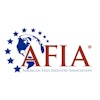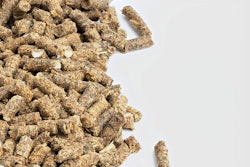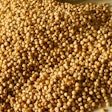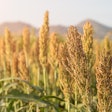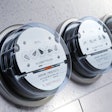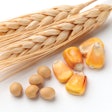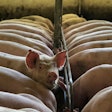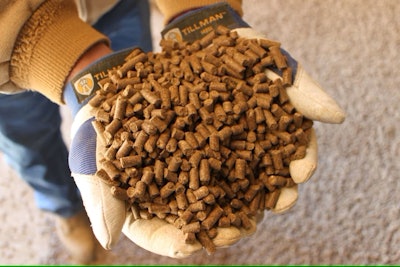
To achieve pellets that balance durability, nutrient stability and handling efficiency, many feed mills turn to specific additives that serve as binders, lubricants and conditioners. These pelleting aids optimize cohesion, control moisture and reduce fines, offering practical solutions for common pelleting challenges. Of course, such products are not inexpensive, but in most cases it is a question of keeping or losing a customer or even a market segment.
Key pelleting additives and their benefits
1. Binders: improving pellet durability
Binders improve internal cohesion, creating pellets that resist crumbling and breakage. A durable pellet does not always mean a hard pellet, and care should be taken to this direction, as young animals often reject hard pellets. Nevertheless, below are some of the most effective binders (in my experience, so far):
- Lignosulfonates: These are widely used in animal feeds that need a strong pellet. Lignosulfonates create strong, durable pellets by forming a binding network within the feed matrix. Their effectiveness and relatively low cost make them a popular choice, especially for feeds with high durability requirements, such as those for poultry and rabbits.
- Bentonite and kaolin: These clay-based binders are very effective for feed durability. Bentonite offers excellent binding strength and enhances water stability, making it valuable in aquatic feeds. Kaolin provides added moisture control, which can help in feeds for animals that benefit from less friable pellets. Note that these names refer to generic products and many clays that are neither are often marketed as such.
- Diatomite: Known for its high absorbency and porosity, diatomite not only acts as a binder but also absorbs excess moisture, improving pellet integrity. It’s especially beneficial for high-fiber feeds, where it prevents clumping and improves feed flow during pelleting.
- Starch-based binders: Corn and wheat starch are natural binders that gelatinize under heat and pressure, improving pellet cohesion. When cost-effective, these starches enhance pellet quality without significantly altering the feed's nutritional profile.
2. Lubricants: reducing friction for energy efficiency
Lubricants aid in reducing friction within the die, making the pelleting process smoother and lowering energy demands. However, the easier the pelleting process the less durable pellets can be – so both types of additives are often needed. Common lubricants include:
- Vegetable oils and animal fats: While mainly used as energy sources, small amounts of oils or fats provide lubrication in the die, reducing energy consumption and wear on equipment. These additives should be used carefully, as even moderate levels can lead to softer pellets.
- Molasses: Acting as a binder and a lubricant, molasses enhances pellet cohesion while easing die friction. Its sweet taste improves palatability, making it especially useful in ruminant feeds.
- Diatomite: With its ability to absorb excess moisture, diatomite can indirectly reduce die friction by preventing material clumping, thus facilitating a smoother pelleting process.
3. Conditioners for moisture management and stability
Conditioners control moisture within the feed, which is crucial for maintaining pellet structure and stability. Their use is becoming more apparent the older the pelleting facilities are because of the lack of sophistication in automatic moisture management. Additives that support this role include:
- Glycerin: As a hygroscopic compound, glycerin manages moisture within the pellet, helping control pellet hardness and preventing brittleness. It’s also highly palatable, making it an ideal additive for feeds targeting young animals or those with high energy needs.
- Calcium lignosulfonate (CLS): While mainly a binder, CLS also acts as a conditioner by enhancing moisture distribution within the pellet, reducing dust and improving handling. CLS is particularly effective in feeds for swine, poultry, rabbits and aqua feeds, where pellet integrity is critical.
- Steam and water as conditioners: Standard in most pelleting operations, steam and water conditioning pre-gelatinizes starch and denatures proteins, which improves binding during pelleting. This conditioning is critical to reduce fines and enhance nutrient absorption.
4. Specialized pelleting aids
Certain additives cater to specific requirements, improving pellet quality for niche feed formulations:
- Phosphates (mono- and si-calcium phosphate): In addition to providing essential minerals, phosphates enhance pellet durability by aiding mineral binding within the feed.
- Hemicellulose extracts: These plant-based extracts form a gel-like structure in the feed, offering strong binding properties. They’re particularly beneficial for high-fiber feeds, where additional binding support is needed to create a cohesive pellet. Here, a moisture management conditioner is also beneficial.
- Guar gum and xanthan gum: Both are effective binders that enhance pellet cohesion, especially in aqua feeds where water stability is crucial. Their gelling properties improve feed durability, which helps maintain nutrient delivery in water environments.
- Gelatin: An animal-derived binder, gelatin provides a robust structure that supports high-quality pellet formation. Its use in feeds for young animals, such as piglets, enhances pellet strength without compromising nutritional quality.
Practical benefits of pelleting additives
In summary, adding these pelleting aids offers numerous advantages for feed production, including:
- Enhanced pellet durability: Binders like lignosulfonates, kaolin and diatomite strengthen pellets, reducing fines and breakage. This is essential for feeds with high durability requirements, such as poultry and rabbit pellets.
- Improved processing efficiency: Lubricants reduce friction and heat, decreasing energy costs and extending the lifespan of pelleting equipment. This efficiency is especially beneficial in high-volume feed mills.
Consistent nutritional delivery
Conditioners and binders protect pellet structure, ensuring nutrients remain intact during transport and storage. Diatomite, for example, helps stabilize nutrients by controlling moisture, making it valuable in feeds requiring longer shelf life.
Strategic use of pelleting aids can enhance the quality and consistency of pelleted animal feeds, optimizing the production process and nutritional value. These additives not only improve pellet durability and reduce energy costs but also ensure feed mills can meet the specific dietary needs of various animal species. However, using all of them is not the solution to the perfect pellet. Each additive should be evaluated by an experienced nutritionist to fit the feed formula in question – and when the basic formulation changes, such additives should be re-evaluated.
